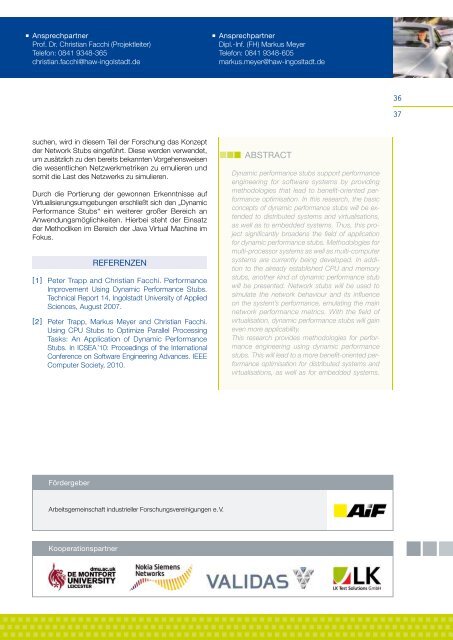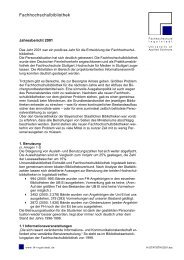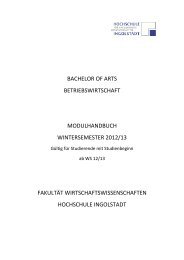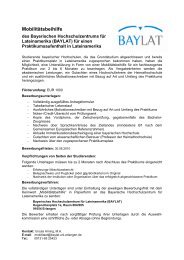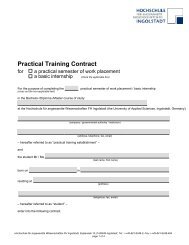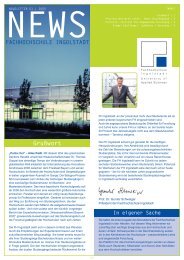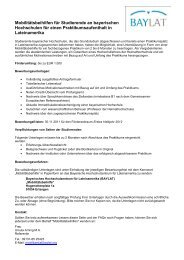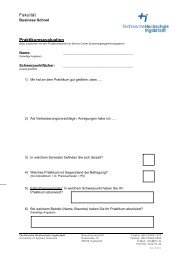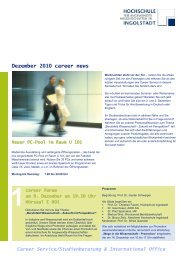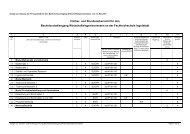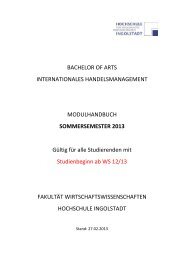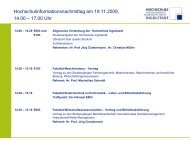Forschungsbericht 2010 - Hochschule Ingolstadt
Forschungsbericht 2010 - Hochschule Ingolstadt
Forschungsbericht 2010 - Hochschule Ingolstadt
Sie wollen auch ein ePaper? Erhöhen Sie die Reichweite Ihrer Titel.
YUMPU macht aus Druck-PDFs automatisch weboptimierte ePaper, die Google liebt.
Ansprechpartner<br />
Prof. Dr. Christian Facchi (Projektleiter)<br />
Telefon: 0841 9348-365<br />
christian.facchi@haw-ingolstadt.de<br />
suchen, wird in diesem Teil der Forschung das Konzept<br />
der Network Stubs eingeführt. Diese werden verwendet,<br />
um zusätzlich zu den bereits bekannten Vorgehensweisen<br />
die wesentlichen Netzwerkmetriken zu emulieren und<br />
somit die Last des Netzwerks zu simulieren.<br />
Durch die Portierung der gewonnen Erkenntnisse auf<br />
Virtualisierungsumgebungen erschließt sich den „Dynamic<br />
Performance Stubs“ ein weiterer großer Bereich an<br />
Anwendungsmöglichkeiten. Hierbei steht der Einsatz<br />
der Methodiken im Bereich der Java Virtual Machine im<br />
Fokus.<br />
referenZen<br />
[ 1 ] Peter Trapp and Christian Facchi. Performance<br />
Improvement Using Dynamic Performance Stubs.<br />
Technical Report 14, <strong>Ingolstadt</strong> University of Applied<br />
Sciences, August 2007.<br />
[ 2 ] Peter Trapp, Markus Meyer and Christian Facchi.<br />
Using CPU Stubs to Optimize Parallel Processing<br />
Tasks: An Application of Dynamic Performance<br />
Stubs. In ICSEA ’10: Proceedings of the International<br />
Conference on Software Engineering Advances. IEEE<br />
Computer Society, <strong>2010</strong>.<br />
fördergeber<br />
Arbeitsgemeinschaft industrieller Forschungsvereinigungen e. V.<br />
Kooperationspartner<br />
Ansprechpartner<br />
Dipl.-Inf. (FH) Markus Meyer<br />
Telefon: 0841 9348-605<br />
markus.meyer@haw-ingosltadt.de<br />
AbstrAct<br />
Dynamic performance stubs support performance<br />
engineering for software systems by providing<br />
methodologies that lead to benefit-oriented performance<br />
optimisation. In this research, the basic<br />
concepts of dynamic performance stubs will be extended<br />
to distributed systems and virtualisations,<br />
as well as to embedded systems. Thus, this project<br />
significantly broadens the field of application<br />
for dynamic performance stubs. Methodologies for<br />
multi-processor systems as well as multi-computer<br />
systems are currently being developed. In addition<br />
to the already established CPU and memory<br />
stubs, another kind of dynamic performance stub<br />
will be presented. Network stubs will be used to<br />
simulate the network behaviour and its influence<br />
on the system’s performance, emulating the main<br />
network performance metrics. With the field of<br />
virtualisation, dynamic performance stubs will gain<br />
even more applicability.<br />
This research provides methodologies for performance<br />
engineering using dynamic performance<br />
stubs. This will lead to a more benefit-oriented performance<br />
optimisation for distributed systems and<br />
virtualisations, as well as for embedded systems.<br />
36<br />
37


